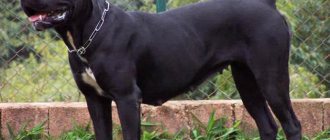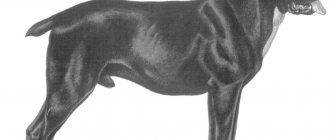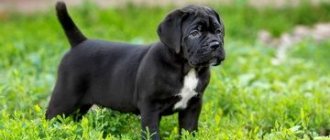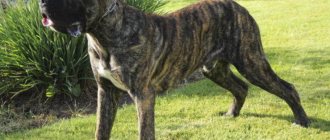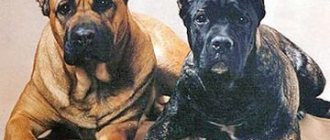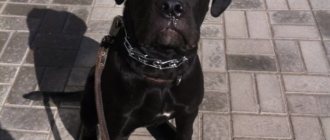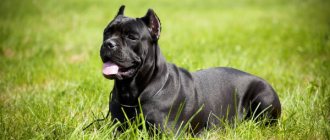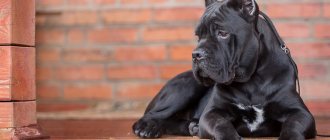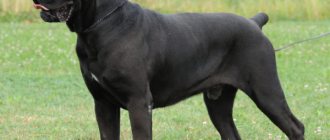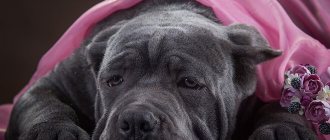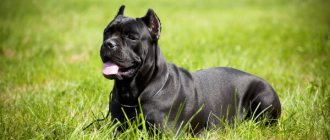Photo: dogfact.ru Cane Corso is a dog for gladiator fights and one of the most ancient breeds in the world. Strong and resilient protectors, reliable working dogs and faithful guards - all these are Cane Corsos. In our latitudes, this amazing breed is not yet so well known, but is gradually becoming more and more popular. So let’s talk about its features and specifics of care!
Story
Italian Cane Corsos have a rich history. The breed comes from Molosson dogs that existed in Ancient Rome. Molossoon dogs descended from mastiff dogs, which were gladiatorial and guard dogs among the inhabitants of Carthage. However, the Italian Mastiff is not a fighting breed. This is primarily a guard dog.
Even the name Cane Corso itself means, translated from Latin, “guard dog” (“canis” - dog, “cohors” - guard, security guard).
The inhabitants of Italy combined in these dogs such qualities as loyalty, love for children, security and hunting skills. Dogs looked after children, helped herd livestock, and reliably guarded houses.
The following fact is interesting in the history of this breed: they were practically exterminated. But there were Italians who revived the true Cane Corso, looking for individuals throughout Italy. The fact is that dog breeding after the fall of the Great Roman Empire was carried out by ordinary people. The nobility did not accept this breed. They did not want to keep such large dogs at court. So this breed became a “folk” breed, so people did not carry out targeted selection. As a result, the single breed split into several species. However, there was a group of Italians who decided to revive the endangered species like the Phoenix. Thanks to these Italian enthusiasts, we can now meet this beautiful animal.
How to choose a puppy
The Cane Corso is a prestigious breed, it is very fashionable to keep it, but acquiring a purebred healthy puppy is a big problem. You should only buy a dog from an official breeder, who will present all the documents for the pet, tell you about the litter and breed line, answer questions, and show the parents.
Puppies must meet standards, be active, healthy and happy. The price of such a dog can sting painfully.
For a puppy without a pedigree you will have to pay 12-15 thousand rubles . A descendant of champions, suitable for exhibitions, will cost 50 thousand rubles .
The Cane Corso is a wonderful working and guard dog breed that will serve its family faithfully. She will give all the love to her household and become the best protector for children and adults. But maintaining such a pet will require huge material costs.
5 / 5 ( 1 voice )
Types and types
Mastino
Massive, somewhat heavy and loose dogs with raw, saggy, thick lips. Drooping eyelids are characteristic. There are a very large number of skin folds. The neck is somewhat short. There is excess suspension. They have similar features to Mastino Neapolitan.
Great Dane
Dogs of this variety are very large in size, tall on their legs, not powerful enough and bony, lightweight. Their chest is narrow, sometimes excessively elongated. The head is not large, the forehead is flat, the transition from the forehead to the muzzle is smoothed. The lines of the forehead and the back of the nose are parallel. The cranial part is not voluminous enough, elongated, rectangular in shape. Cheekbones are weakly expressed. The muzzle is long and narrow. Great Dane features are present.
Bullmastiff
Dogs of this type have very good physical fitness. These are massive dogs with a deep chest, a strong, wide and strong back. The spherical shape of the head is similar to that of a bullmastiff. This similarity is due to a round (and not square, like other types) skull, an overly rounded forehead, close-set small eyes, an overly short (in proportions less than 34%) muzzle with many folds, thick, raw lips and drooping cheeks.
Boxer
This type is characterized by a small size, stockiness, “square” shape and barrel-shaped chest. Characterized by a round skull, very pronounced cheekbones, a raised muzzle, and a concave bridge of the nose. The straight profile of the muzzle is broken, the lower jaw protrudes too forward. Bite: big bite. Round eyes.
American Staffordshire Terrier
Dogs of regular build and small size. The muscular system is well developed. The shape of the head is reminiscent of the American Staffordshire Terrier due to the convergence of the lateral lines of the muzzle, forming a wedge-shaped muzzle tapering towards the nose (especially visible when viewed from above), and an insufficiently voluminous and deep, somewhat flattened skull (when viewed from the side). These dogs are often very aggressive.
So, then you will read a description of the breed, its character, read reviews, and also learn everything about proper care and maintenance.
Character
Most often, the character of an animal can be judged by the task for which it was bred. It’s difficult in this regard with Cane Corso: over their long history, they have managed to be fighting dogs, shepherds, security guards, bodyguards, and just friends. Therefore, their features do not have a clear connection to any one purpose.
- devotion. The Cane Corso is one of those breeds that choose one owner and remain loyal for life. Of course, they will love the owner’s children, their partner, their elderly parents, and even their beloved canary, but they will all forever remain in second place. This does not affect behavior; the dog is equally obedient to all family members. But it affects the feelings: if the owner leaves, the Corso will be sad and even increased attention from other familiar people will not be a consolation. That’s why dogs have a hard time coping with a change of owner. Sometimes it happens that the new owner cannot take the place of the old one in the dog’s heart.
- equilibrium. If a large animal flinches at every rustle, is nervous and easily excitable, it will become dangerous. That’s why Corsos are quite phlegmatic and cope well with stress. Their peace of mind is not shaken by loud arguments, moving, children trying to play with their tail, or sudden loud noises. Only disapproval or absence of the owner can seriously affect the dog’s condition.
- security qualities. Even an untrained Corso exhibits the habits of a guard. He is suspicious of strangers, does not allow strangers near the owner’s children and property if the owner himself is not around, and does not like familiarity. There is no prohibition against aggression towards humans in his genes, therefore, if his charges are in danger, the dog will protect them at all costs. It’s not scary to let the children go out with him.
- caring. These are echoes of the times when Corso lived in peasant families, looked after herds and looked after children. Since then, they get along well with other dogs and small animals. They feel a reverent love for children and are happy to look after the kids, play with them and have fun.
These are smart, calm dogs who obey their loved one not out of fear, but out of conscience, and are surprisingly flexible for their size. All that is required from the owner is to explain the rules to the Corso, show what needs to be feared in the world around him, and what is harmless, and not spoil anything in the psyche.
Advantages and disadvantages
The advantages are the following:
- They are excellent guards and defenders. With them you don’t have to worry about your home, and when you go out for a walk at night, you don’t have to worry about meeting bad people.
- They are very smart and flexible. Even with teenagers there are usually no problems.
- They are happy to benefit. Carry shopping bags? Keep an eye on small children? Drive away a stranger? Corso will be happy to do this.
- They lack hunting instincts. They won’t chase cats, try to grab every squirrel in the park and be distracted by unfamiliar smells. They get along easily with other animals.
There is little that can confuse or frighten them - their psyche is stable and able to cope with stress, especially if people are ready to help a little.
But everything is never perfect, which means there are also disadvantages:
- The dog will need adequate training. He must distinguish where the owner is being attacked and where they just want to hug him, he must not be afraid of the city and must neutralize the stranger, and not try to bite him to death. To do this, he will have to take courses where he will be trained as a defender. And even earlier, you will need to be able to explain to the baby what is possible, what is not, when a person is happy and when he is not. And this will require not only time, but also strength and patience.
- Will need care. Corsos shed constantly, so you will have to devote time to caring for the coat. They also eat a lot, simply because of their size, and the food must be of high quality.
- You will need attention and love. This is not a dog that can live in a yard or mind its own business most of the time. She needs to be close, interact, play, or at least lie at her feet, enjoying the presence of her person.
- Long, pleasant walks are needed. You need to run, play and exercise with the animal so that it has time to get exhausted and when it comes home it just falls asleep. Therefore, it is not suitable for the sick, the elderly and not very active people.
Due to the structure of the muzzle, the Corso constantly salivates - this is typical for flat-faced mastiffs in general. The fur also gives off a faint dog smell, and individual hairs constantly fall around. Therefore, they are not suitable for people who like sterile cleanliness to reign in their home.
Description of the breed
Colors
Since the color of a dog is a genetically determined phenotypic trait, the color of the puppies can be determined by the color of the parents. Also, thanks to color, you can determine the “purebred” of the offspring. Now about colors in more detail.
ATTENTION ! Cane Corsos are not white. They can be any shade of gray with a mask on the face that does not extend beyond the eyes. Small white spots are allowed on the chest, tips of the paws and bridge of the nose.
Standard colors for Corso Italiano:
- Black;
- All shades of gray;
- Light red;
- Murugiya;
- Brown;
- Brindle (dark stripes on red or gray fur).
For red, murugi and brindle dogs, a mandatory criterion is the presence of a mask on the face.
Brindle, black, gray and blue colors in the photo:
Gray blue Cane CorsoMurugiya:
Formentino color:
You should not chase so-called “fashionable” shades of wool. Most often, they are not purebred, so such individuals are not taken for mating. If you are going to breed a Corso, you should give preference to standard colors.
Standard
- Head: large, classic Molosson.
- Skull: wide. When viewed from the front, it appears convex. From the back to the occipital protuberance it is flat. In the area of the cheekbones, the width and length of the skull are almost equal to each other. The frontal groove is clearly defined. The axes of the skull and muzzle converge somewhat.
- Stop (transition from forehead to muzzle): Well defined.
- Nose: black, large with wide nostrils.
- Muzzle: Strong, square, short (skull to muzzle ratio 2:1) and flat.
- Bridge of the nose: straight.
- Lips: Since the upper lips hang down and cover the lower jaw, the lower profile of the muzzle is entirely determined by the upper lips.
- Teeth and jaws: The number of teeth is 42. The Cane Corso's teeth are white, clean, and healthy. The jaws are powerful, curved and large. The bite is a slight underbite (the lower jaw protrudes slightly forward).
- Eyes: usually dark in color (shades may vary). They look strictly straight. Size is medium. Oval shape. Slightly convex. The eyelids fit closely.
- Ears: Uncropped ears, triangular in shape, widely spaced and drooping. The ear flap is close to the head. Cropped ears have the shape of an isosceles triangle.
- Neck: strong. The muscular system is well developed. The ratio of neck length to head length is 1:1.
- Body: the body is strong, with pronounced muscles. Looks longer than the height at the withers.
- Withers: well defined. Protrudes above the back of the dog's body.
- Back: straight, very muscularly developed.
- Hindquarters (croup): partly sloping, long, wide.
- Chest: wide, well developed, reaching to the level of the elbow joints. The ribs are slightly convex.
- Tail: High set and thick at the base. The undocked tail is long, reaches the tarsal (hock) joints, is always carried high, does not arch or assume a vertical position.
- Forelegs:
- Shoulders: long, inclined, with highly developed muscles;
- Shoulders: strong;
- Forearms: strong, smooth;
- Wrists and metacarpus: flexible, elastic;
- Forepaws: cat-like, oval, with toes close together. The pads are elastic. The claws are strong and hard.
Hind limbs:
- Hips: wide, long, have a convex back line of the thigh;
- Shins: durable;
- Hock (tarsal) joint: somewhat angular;
- Hocks: sinewy, powerful;
- Hind feet: oval. Fingers bunched together. The pads are elastic. The claws are hard.
Dimensions
Cane Corso puppies are very tiny and their weight is very small. They are born with a body weight of 300-700 g. Then, by 2 months, the babies become strong and weigh up to 9 kg. The difference between females and males at this age is about 200-300 g. Let’s track the dynamics of the puppy’s weight by month depending on its gender!
Table of height and weight of puppies by month:
But the height of females and males has a more noticeable difference. So, at 2 months, females have 32 cm at the withers, and males - 44 cm. In the third month of life, boys grow to 49 cm. Girls grow somewhat more intensively. Their height at 3 months is on average 42 cm.
Over the next 2 months, the puppies are still growing quite quickly. Thus, for males, the height at the withers at 4 and 5 months is 56 and 62 cm, respectively, for females - 47 and 55 cm. Weight, respectively, for males is 16.5 and 24.5 kg, for females - 18 and 22.5 kg.
1 week 1 month 2 months and 1 week
3 month old puppies in the photo
4 months photo
Then the growth rate slows down. Males by 6 months grow to 64 cm, by 7 - up to 65 cm, by 8 - up to 65.5 cm and then up to a year they grow by 1 cm per 2 months. Accordingly, by one year their height at the withers is 67 cm. Over the next year they also grow only a centimeter.
Dimensions of an adult male: height is on average 67-68 cm. Females grow a little differently. At 6 months, babies reach 57 cm, at 7 - 58 cm, at 8 - 59, at 9 - 59.5 cm. Then they grow by 1 cm per month until the age of 1 year. Then, before reaching adulthood (2 years of age), they, like males, grow by an average of 1 cm. Accordingly, an adult female at the withers is 63-64 cm. Next, about weight.
Weight of males by age:
- 3 months – 13.5 kg;
- 4 months – 16.5 kg;
- 5 months – 24.5 kg;
- 6 months – 31.5 kg;
- 7 months – 37.5 kg;
- 8 months – 40 kg;
- 9 months – 42 kg;
- 10 months – 44 kg;
- 11 months – 45.5 kg;
- 12 months – 47.5 kg;
- 24 months – 50 kg. The weight of an adult dog usually ranges from 50 to 60 kg, but there are exceptions.
Weight of bitches by month:
- 3 months – 12.5 kg;
- 4 months – 18 kg;
- 5 months – 22.5 kg;
- 6 months – 28 kg;
- 7 months – 33.5 kg;
- 8 months – 36 kg;
- 9 months – 38 kg;
- 10 months – 42 kg;
- 11 months – 41.5 kg;
- 12 months – 43 kg;
- 24 months – 45 kg.
REFERENCE . According to the ICF classification standards, a height deviation of 2-3 cm is allowed.
Barking
Another advantage of this breed is that the Corso will not bother its owners with excessive barking. They bark when necessary to attract the attention of their owners. The Italian Mastiff has a low, rough voice, which is an excellent deterrent quality for uninvited guests.
Drooling
This is the disadvantage of the Cane Corso: the dog is very, very slobbery. This is partly due to the structure of her upper hanging lips.
Is this a fighting dog?
Looking at the frightening appearance of the Cane Corso, many would classify it as a fighting dog. However, this breed is not a fighting breed. She does not show excessive aggression and does not participate in battles. This dog is a guard and an excellent companion.
First 2–3 months
This is the ideal period to wean your baby from his mother. He can now fully feed himself. His diet should include meat, vegetables, cereals and dairy products.
At 2–3 months old, puppies are very inquisitive. They enjoy exploring the world around them, play a lot and have fun. During this period, they need love and affection more than ever.
You can actively start learning. After the puppy learns its name, you can start using the simplest commands (“Fu!”, “Come to me!”, “Place!”).
Peculiarities
Let's look at the important features of the Italian Mastiff breed:
Diseases
The most common problem is hip dysplasia . It has both genetic and social factors of occurrence. To reduce the spread of pathology, puppies should be x-rayed at the age of 12 months to check for dysplasia. In its absence, mating can be carried out.
IMPORTANT . The absence of signs of femoral dysplasia during X-ray examination does not guarantee that dysplasia will not appear in the offspring.
With improper feeding, the development of gastrointestinal tract pathologies is possible:
- pancreatitis,
- hepatopathy,
- enteropathy,
- gastritis,
- gastroenteritis, etc.
Cupping
ears
Ear cropping is an optional operation, but most owners still answer “yes!” when asked “do they crop their ears?” The breed standard requires docking. Cropping the ears also gives the dog a more masculine appearance. But if the owner bought a PET-class dog “for himself” and wants his Corso to have fold ears, he has the right to keep the pet’s ears.
The correct form for ear cropping on a Cane Corso:
At what age is it better to crop ears: from 2.5 to 3.5 months. A prerequisite is a series of vaccinations before surgery. 10 days after vaccination, ear cropping can be performed. Healing time is 7 days. The ears are docked according to the standard at 2/3 in the form of an isosceles triangle.
Undocked Italian Mastiff dog with ears in the photo:
Ears before and ears after cupping:
Tail
Tail docking is also optional. However, in order for the dog to meet the standards, this procedure is necessary. It is carried out according to the standard from the 4th vertebrae. At what age is the tail docked? As a rule, this manipulation is carried out together with ear cropping at 2.5 – 3 months.
REFERENCE . Ears and tail docking can be done at any age, but the older the dog, the more difficult the operation and postoperative period will be. Therefore, there is no need to waste time.
Photo of an adult dog with ears and tail:
Possible diseases and methods of treating them
The voluminous body of the Cane Corso is a tasty morsel for parasitic creatures such as fleas, ticks and worms. The presence of these parasites significantly reduces the dog's quality of life. She becomes restless and eats poorly. In addition, her immune defense deteriorates. What to do in this case? Antiparasitic treatment. It should be carried out annually, even for preventive purposes.
Some large pets often experience otitis media or other ear diseases. Usually their appearance is associated with improper care. To prevent the occurrence of such a disease, regularly inspect your dog's ears for wax. If there is any, remove it with a napkin. If the veterinarian confirms the presence of otitis media, you will have to purchase special medicinal drops.
And, of course, don’t forget about strengthening your pet’s health with proper nutrition. Don't skimp on his diet! Buy only high-quality commercial diets. In winter, give him vegetables and fruits to replenish the lack of vitamins in his body.
Where is the best place to buy?
List of the best dog kennels of this breed for purchasing puppies:
- Dynasty of Champions. Owner Gaidukova Emilia. Phone +7(916)588-40-58;
- Exclusive-N. Owner Belykh Natalia Mikhailovna. Phones +7 (495) 502-59-30,,
- From the Constellation Adomas. Phones, +7 (903) 777-10-72
- Bohema Blaze. Phone: 8-910-433-40-20
- Corsle Garnet. Phones, 8-911-263-50-12
- Cane Forevo. Phone, 8-911-216-74-93
- La Mia Corsiero Phone +7-962-686-29-85
How to choose a puppy?
Breed diseases
The description makes it clear that this is a breed with a long, complex history. And like any other with a long, complex history, she carries with her a burden of genetic errors and defects that affect her health. Of course, breeders do tests and carefully select dogs without bad heredity, but still there is a predisposition to certain diseases:
- Hip dysplasia. Often found, and not only in large dogs. It occurs suddenly - lameness, severe pain, the dog complains and does not step on its paw. Treatment is long and difficult, so reputable breeders either provide test results indicating that the puppy does not have a tendency to dysplasia, or do such tests at the request of the future owners.
- Allergy. It most often manifests itself as allergic reactions to food - redness, rash, itching, and sometimes breathing problems. All representatives have a tendency to it, so owners are advised to consult with a veterinarian in advance and choose the appropriate food.
- Epilepsy. Epileptic seizures negatively affect the dog’s nervous system, and any chaotic flickering of lights can provoke them. Epilepsy cannot be treated, it can only be suppressed with medication, which is why animals with it are not sold for sale.
- Thyroid diseases. They make the pet irritable, nervous and disobedient, causing them to gain weight sharply or, on the contrary, lose it. They are treated with constant use of hormones, which is expensive, and such animals are not allowed for sale.
- Eye diseases. Most often - inversion or inversion of the eyelid. It can be treated surgically, but is still inherited, which is why representatives with it are sold as a pet class, not available for reproduction.
The list is far from the most impressive - many suffer from a much larger number of diseases.
The main task of a person is to choose a puppy that will be healthy in all respects.
Cost of a puppy: how much does it cost (price in rubles)?
How much does a dog cost? The price of an Italian Mastiff puppy depends on its class. Without a class, a puppy costs 10-15 thousand rubles, a PET class puppy - 20-45 thousand rubles, BRID class - 45-65 thousand rubles, SHOW class - from 65 thousand rubles.
REFERENCE . PET-class (from the English Pet - pet) - puppies that do not meet the breed standards according to the classification of the International Canine Federation (FCI) or have any deviations that do not threaten the health and behavior of the dog. BREED class (from the English Breed - tribe, breed) - puppies with a wonderful pedigree and good hereditary characteristics. SHOW class (from the English Show - display) - the best puppies of the litter. They have excellent health and do not have a single defect. Meets all standard criteria.
Protective and guard qualities
The dog is tolerant of the owner's guests if they are not aggressive. But if he finds a stranger on the territory, he will not let him leave. At the first opportunity, Corso will fearlessly grab him and crush him with steel muscles and a death grip. At such moments, it is impossible to appease the dog with a treat or distract it with a toy.
For its size, the dog is surprisingly agile, dexterous and capable of overcoming difficult obstacles in pursuit of a criminal.
Cane Corso: photo, character, puppies, standards, all about the breed
Owner reviews: negative and positive
Let's read real and honest reviews from owners about the Cane Corso dog breed:
Karina
I have 4 dogs of this breed. And I'm absolutely delighted! Very playful and kind. They love to spend time with children. My nanny assistants!
Igor
I have a Cane Corso dog. One day I sat at the computer late at night. The lights in the house are turned off. Then I hear my Arthur growling! I'm going to the window right away. He never growled like that, especially at night. I look - the thief is frozen on the fence! Apparently, he tried to climb over, but heard a growl. Of course, anyone would be scared of such a roar! Arthur received a tasty bone for his vigilance, and the thief received a trip to the police station.
Natalia
The dog's character, of course, is not bad, but how much drool does it make... I'm already tired of scrubbing these "surprises" from my favorite carpets! Simply terrible!
Olga
I had a disagreement with my neighbors because of my beauty. You see, their children climbed into my garden for apples. And now I have my own Milana, the neighbors’ offspring are so afraid of her! You see, she growls at them! Heh! I love my protector. Now I don’t have to worry about my apples.
Matvey
My wife and I have 2 cats and a Cane Corso. They were immediately afraid for their relationship. But in vain! Friends, don't spill water. Cats love to sleep on the Burrow. Animal lovers, fear not! The Cane Corso will find a common language with your pets.
Attitude towards children
The Cane Corso treats children with care, with a share of “parental” attention. He will never offend the weak and will tolerate even inaccurate advances from strangers. If the Corso gets tired of children's attention, he will try to leave, and if he cannot, he will courageously endure manifestations of love.
Unlike other large dogs, the cane is well aware of its size and behaves carefully with children. It will not crush even the smallest ones with its own weight. The worst punishment for a sensitive cane is the childish tears of a child under his care.
Characteristics: pros and cons
Let's look at the detailed characteristics of dogs:
pros
- Dogs are very smart . They immediately get used to the owner and his family. There is no need to instill special socialization skills in them. They are also very easy to train. They can often do what the owner says the first time. If the owner brings a person into the house and tells the Corso that this person is a friend, then one should not expect aggression from the dog.
- Ukane Corso has a great character! They get along very well with small children . We are ready to endure all their antics and games.
- They get along well with other pets , including cats.
- They have a sense of proportion. This means that the Italian Mastiff will never cause any harm during play. But in case of danger it can literally tear a person apart.
- Wonderful security guards . The breed's ability to guard is inherent at the genetic level.
- During walks, they always watch the owner, as a result of which they rarely get lost .
- During estrus, bitches take care of themselves independently . The owner may not even notice that his female dog is in heat. These dogs tolerate heat calmly.
Cons of the breed
- Cane Corsos have an interesting character trait: they are very dependent on their owners . It is better for elderly people and workaholics not to get such a dog, as they will not be able to pay the necessary attention. Also for this reason, it is very difficult to leave a pet for a long time (leaving somewhere for a long time) - the animal is very sad.
- Traumatic . If the Corso gets angry, you can get injured, which can even lead to disability and death.
- Sheds a lot.
- Requires physical activity , as the dog is very active.
Wool is everywhere, bring a vacuum cleaner: shedding in dogs
Lifespan
On average, dogs of this breed live 10-11 years.
IMPORTANT!
If you monitor your dog's health and regularly visit the veterinary clinic, he can live up to 14 years.
The main conditions affecting the life expectancy of an animal are:
- Cane Corsa physical activity, frequent walks with active games;
- proper nutrition, complete and enriched with vitamins and minerals;
- timely elimination of illnesses and injuries.
Conditions of detention
Can I keep it outside?
If the dog is raised correctly, it is allowed to be kept in an apartment. However, it should be taken into account that the Cane Corso is a large dog and it needs a lot of free space, so place it in a one-room apartment of 20 sq.m. - not the best idea.
The best option is a private house, where there will be enough space in the yard for the dog’s entertainment and active recreation and a kennel (without a chain!). Also, the dog will be able to perfectly monitor what is happening in the territory.
IMPORTANT! Enclosures for Cane Corso are not 100% suitable! The dog cannot tolerate cold and restrictions of freedom.
The booth should not be made very large so that the dog does not freeze, but can enter, lie down and exit without obstacles. To do this, it is best to measure your four-legged pet when it is standing and when it is lying down.
Comfort and beauty for cheap: do-it-yourself dog house
Walks
The Italian Mastiff is a physically developed dog, so it requires active rest. To do this, you can give her walks on the street at a distance of 4-5 km every day, as well as active games with the help of sticks, flying saucers, balls and other things.
Key points in training
You need to start raising Corse as early as possible; from the first days of his life, he needs to be accustomed to a daily routine, an outdoor toilet, walking, and the ability to walk on a leash and without it.
From 4 months you can begin to train intensively. Many dog handlers recommend taking your puppy through the “dog in the city” program, which will teach the pet to live among people, walk in public places and quickly respond to the owner’s commands.
Cane Corsos are not particularly stubborn and do not try to dominate, so they are easy to train and understand people. Such a dog must know the commands:
- "Near";
- "It is forbidden";
- "Sit";
- "Place";
- "Voice";
- "Quiet".
Rough treatment, punishment and harsh methods are not needed; the dog may become offended and withdrawn.
Read about how to properly train a dog in the article: “Training a puppy: effective methods from dog handlers, learning commands at home.”
Necessary care
Find out what kind of dog care is needed:
Nutrition: what to feed?
- Cane Corso often has allergic reactions to certain foods, so you should start feeding the dog carefully so that it is possible to identify a possible allergen and remove it from the dog’s diet. It should be noted that due to this problem, owners have to buy specialized hypoallergenic food, which is an expensive pleasure.
- Weight control is necessary . The Corso Italiano loves to eat, so the owner must monitor the amount the dog eats, divide the food into 2-3 meals per day and in no case overfeed.
- The amount of carbohydrates should correspond to the energy consumed. The less physical activity a dog does, the less carbohydrates it needs.
- What is the best food for Cane Corso? Natural food, even of the best quality, does not always contain a sufficient amount of microelements and vitamins for a dog. Therefore, it is better to give preference to premium industrial food for Cane Corso (Royal Canin, Pro Plan and others).
- If your dog gets tired of dry food, you can periodically dilute the diet with canned food and preserves from the same manufacturer.
Feeding and nutrition of the puppy
Combing and washing
Since the dog is very shedding, and throughout the year, it will have to be combed daily with a hard brush. The dog should be washed as needed (there is no specific framework).
Proper care of a dog's fur: what to comb and how to comb out tangles?
What to feed your Cane Corso
It is best to feed your Cane Corso a balanced diet for large breeds. The diet must contain vitamins, fish oil, protein and collagen. It is important to periodically change the diet, depending on the age, load and health of the animal.
A puppy up to 4 months old is fed five times a day, and in strict doses, because they cannot overeat. You need raw beef, boiled poultry, rabbit and some porridge, oatmeal, carrots and sour milk. Dairy products and cottage cheese are given in doses, because an excess of calcium is fraught with joint problems.
Photo: placepic.ru
For puppies up to one year old, it is time to introduce beef bones into their diet and increase the amount of calcium. Gradually he is transferred to three meals a day and the caloric content of food is increased in proportion to the load. You should not give your Cane Corso food too fatty - this will almost guarantee problems with the liver and pancreas.
After a year, dogs seem to be able to eat forever because their muscle mass increases. Offal and offal are suitable - they are rich in essential microelements and collagen. Sometimes you can give seasonal vegetables, fruits, berries and even nuts. Adult Kane Koso eat twice a day, and the basis of the diet is raw or boiled meat, boiled vegetables and cereals.
Photo: youtube.com
Training and education
How to educate? The main requirement for raising a Cane Corso is early socialization. It is better to show the puppy to the owner early so that he can get used to him and love him. Then there will be no problems with education. The owner needs to show his leadership in the family. Representatives of the breed are easy to train even at home at a young age. It should be borne in mind that if you do not give the puppy proper attention, he will translate this deficiency into aggression, and an aggressive Cane Corso is a ticking time bomb.
Raising a puppy: baby makes a bite
Cane Corso - photo
The Cane Corso breed is so powerful and spectacular that it is impossible to remain indifferent. So we couldn’t while we were preparing this selection of photos for you!
Photo: id.pinterest.com
Photo: corso-club.com
Photo: klkfavorit.ru Photo: 74.ru
Photo: pinterest.ru Photo: lapkins.ru
Photo: barbos.club
Photo: glorypets.ru
Photo: regionoperator.ru Photo: krasivosti.pro Photo: krasivosti.pro Photo: for-pet.ru
Photo: star-karuna.ucoz.ru Photo: sobakevi4.ru
Photo: cat4you.ru Photo: krasivosti.pro
Photo: klkfavorit.ru Photo: kotsobaka.com Photo: zen.yandex.ru Photo: foxfan.ru
Photo: porodisobak.ru
Photo: autogear.ru
Photo: olladaarlekin.com
Photo: youtube.com
Did you like the post? Subscribe to our channel in Yandex.Zen, it really helps us in our development!
Nicknames for boys and girls: what to call them?
When assigning a nickname to a dog, owners are guided by different principles. For example, some are based on the Italian origin of the breed, others take a closer look at the pet, its character and only then give it a nickname. Assigning a nickname is a responsible matter. It is necessary to choose a nickname that will be easy to pronounce and memorable for all family members.
Names for boys:
- Octavian;
- Tiberius;
- Gideon;
- Gilmore;
- August;
- Mussius;
- John;
- Mark;
- Oscar;
- Hart;
- Baron;
- Elf;
- Otis;
- Sam;
- Cleve.
Names for girls:
- Molly;
- Lucky;
- Rhonda;
- Callie;
- Cessa;
- Indus;
- Adela;
- Gloria;
- Betty;
- Karin;
- Lady;
- Honda;
- Shaylee;
- Nellie;
- Melissa.
Up to 8 months
At 7 months the dog will try to consolidate the position of leader. She may not follow already well-learned commands, run away during a walk and go in the opposite direction, or be jealous of the owner of other family members, especially children. If you don’t show toughness during this period, then life with such a dog will be very difficult. Now the owner must make the Cane Corso obey.
Despite its large size, it is still a “child” who is often afraid even of familiar things. The owner must support the pet and show that the object or sound that frightened it is not dangerous.
We recommend this article:
11 must-have commands for dogs and extraordinary tricks
Similar breeds
Who is better for protection: a Rottweiler or an Italian Mastiff?
Many dog lovers puzzle over this question. The fact is that both breeds have similar characteristics in terms of security and watchdog skills. Both dogs will become excellent watchdogs not only for the owner, but also for the territory and property of their family. However, most consider the Rottweiler to be a more suitable guard dog. It's about her character.
The Rottweiler is considered more aggressive than the Cane Corso . He will immediately attack anyone who he deems poses a danger to the territory entrusted to him. If you approach the training of a Rottweiler incorrectly, aggression will transfer to the owners. It’s not for nothing that they say: “If you raised a shepherd, then you did nothing, but if you raised a Rottweiler, then you did a lot.”
The Cane Corso Italiano has a much softer character . They are easier to train and educate. They are devoted to their family. There is no doubt that if the Corso feels danger from another person, he will tear the offender to shreds. But the Italian Mastiff cannot perform only a guard function. This is a more socialized dog than the Rottweiler. She must feel the love of her owners and constantly communicate with them.
Therefore, if someone who wants to get a guard dog has a small family without children or animals, there is a clear leader in the family and he is ready to spend his free time raising the dog, then it is better for him to get a Rottweiler. The Cane Corso is suitable for a large loving family with small children.
Comparison of Italian Mastiff and Boerboel
- The Cane Corso is a highly purebred dog. The Boerboel is not recognized by the Fédération Cynologique Internationale classification.
- Boerboels are more massive than the Italian Mastiff. At the withers, the difference between breeds is up to 12 cm.
- The coat color of the Cane Corso is often black or gray. Boerboels are red.
- Boerboels do not like other dogs. The Cane Corso can get along with any animal.
- The Cane Corso is easier to train.
- Boerboels are terribly aggressive dogs. In several countries around the world, this breed is banned for breeding due to sudden attacks on people. The Cane Corso rarely attacks without reason.
- The Cane Corso requires moderate exercise, while the Boerboel must be properly “tired”, otherwise its physical activity turns into anger and aggression.
- Both breeds are loyal to their owners. However, if the Corso loves all members of his family, then the Boerboel, as a rule, recognizes only one owner-leader.
On the right is an African Boerboel.
Popular colors
There are many shades of animal color.
The most common Cane Corso coat colors are:
- red of various shades;
- grey, from dark to light;
- blue;
- black;
- brindle.
NOTE!
A characteristic feature of the red and brindle Cane Corso is the presence of a gray or black mask on the dog’s face, which does not extend beyond eye level.
The photo below shows one of the variations of the black and brindle color.
Top nicknames
They usually try to name their pets so that the nickname is reminiscent of the Roman origin of the breed. Moreover, they try to choose not just an Italian name or a Latin word, but something short, succinct and simple, so that it is easier for the animal to remember and for the person to use.
For boys: Adri, Albert, Amato, Vitale, Dino, Gino, Italo, Luca, Marco, Mario, Luke, Cesare, El, Yary, Uli, Chris, Tamal, Ares, Zeus.
For girls: Adele, Adona, Alba, Alda, Berta, Bianca, Cinta, Dora, Elda, Hera, Erica, Febo.
The list contains names of gods and goddesses, as well as Italian names denoting beauty, happiness and joy.
Nutrition
In order for your pet to feel physically good, it is necessary to follow a nutritious diet. The amount of food intake, as well as the portion of food, depends on the age of the pet. Owners choose the following types of dog food:
- Dry. A product that is safe for health is expensive, but the owner is freed from regularly preparing a menu for the animal. The finished product contains vitamins, nutrients, and microelements. An experienced veterinarian will help you choose the right dryer. If required, the doctor will recommend additional medications.
- Natural. This is an inexpensive option compared to dry food. The main advantage of healthy food is that the owner knows what the dog is eating. Optimal nutrition: cereals, vegetables, meat (low-fat varieties are used), milk, fish.
During pregnancy, the bitch's diet is changed 14 days before giving birth. It is allowed to purchase vitamins or special food. For the first 7 weeks, the dog eats according to its usual diet, and then the daily portions are gradually increased (attention is paid to cereal products).
Photo and video review
The appearance of the animal in the picture evokes genuine admiration. As a child, these are fluffy little balls that you want to cuddle and take with you. As they grow older, mini corsos acquire a powerful, intimidating appearance.
Interesting Facts
The breed of these Italian dogs is interesting not only because of its long history of existence:
- There are several versions of why Cane Corso received this name. One of the well-established ones is the Latin combination Cane Corso, which translates as “yard dog.” Moreover, the Italians did not use the word cohors by chance - in different interpretations it means “court”, “guardian”, “protector”. So this is nothing more than recognition of the great merits of representatives of this breed to humans.
- In the Roman Empire, Italian mastiffs could fight equally with people and were considered excellent warriors. Often during a battle they were sent into battle first, which helped inflict serious damage on the enemy.
- The pads on the Cane Corso's paws resemble those of a cat, and therefore representatives of this breed, despite their large weight and size, move like a lynx: easily and gracefully.
- These large dogs have a bite force of 700 PSI. According to this indicator, they are second only to the Anatolian Shepherd. The Cane Corso easily chews through the tibia of cattle.
